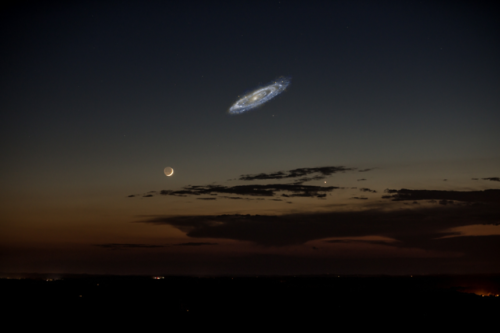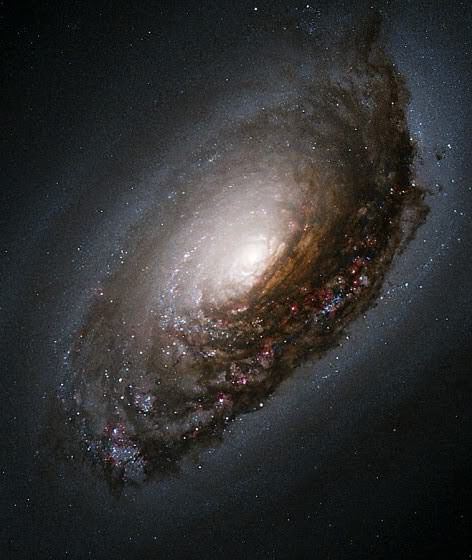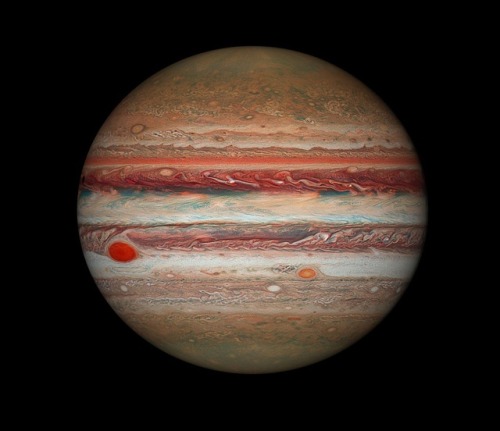Leidenfrost Drops – Liquid Drops That Levitate On A Layer Of Their Own Vapor Over A Hot Surface –

Leidenfrost drops – liquid drops that levitate on a layer of their own vapor over a hot surface – have been all the rage in recent years. We’ve seen how they can be guided, trapped, and self-propelled. What you see here is a bit different. This is a droplet of room-temperature ethanol deposited on a bath of liquid nitrogen. What levitates the droplet in this case is vaporous nitrogen evaporating from the bath.
The droplet is quickly cooling down; it freezes after its second or third bounce off the side walls of the beaker. What causes the droplet to self-propel is an asymmetry of the thin vapor layer beneath the droplet. As soon as some instability causes a slight difference in the thickness of the vapor layer, that triggers the propulsion, which the drop maintains even after freezing. (Image and research credit: A. Gauthier et al.)
More Posts from Riekod and Others

Andromeda’s actual size if it was brighter
via reddit

Venus, Jupiter and Mars at Dawn - Oct 22, 2015
Image credit: Joseph Brimacombe

The faint rings of Uranus, shot in 1986, are made of countless fragments of water ice containing radiation-altered organic material.
Credit: NASA/JPL/Michael Benson, Kinetikon Pictures

M64, The Black Eye Galaxy

Our planet seen from Saturn, captured by the Cassini spacecraft
Image credit: NASA
List of extrasolar candidates for liquid water
The following list contains candidates from the list of confirmed objects that meet the following criteria:
Confirmed object orbiting within a circumstellar habitable zone of Earth mass or greater (because smaller objects may not have the gravitational means to retain water) but not a star
Has been studied for more than a year
Confirmed surface with strong evidence for it being either solid or liquid
Water vapour detected in its atmosphere
Gravitational, radio or differentation models that predict a wet stratum
55 Cancri f

With a mass half that of Saturn, 55 Cancri f is likely to be a gas giant with no solid surface. It orbits in the so-called “habitable zone,” which means that liquid water could exist on the surface of a possible moon. ]
Proxima Centauri b

Proxima Centauri b is an exoplanet orbiting in the habitable zone of the red dwarfstar Proxima Centauri, which is the closest star to the Sun and part of a triple star system. It is located about 4.2 light-years from Earth in the constellation of Centaurus, making it the closest known exoplanet to the Solar System.
Gliese 581c

Gliese 581c gained interest from astronomers because it was reported to be the first potentially Earth-like planet in the habitable zone of its star, with a temperature right for liquid water on its surface, and by extension, potentially capable of supporting extremophile forms of Earth-like life.
Gliese 667 Cc

Gliese 667 Cc is an exoplanet orbiting within the habitable zone of the red dwarf star Gliese 667 C, which is a member of the Gliese 667 triple star system, approximately 23.62 light-years away in the constellation of Scorpius.
Gliese 1214 b

Gliese 1214 b is an exoplanet that orbits the star Gliese 1214, and was discovered in December 2009. Its parent star is 48 light-years from the Sun, in the constellation Ophiuchus. As of 2017, GJ 1214 b is the most likely known candidate for being an ocean planet. For that reason, scientists have nicknamed the planet “the waterworld”.
HD 85512 b

HD 85512 b is an exoplanet orbiting HD 85512, a K-type main-sequence star approximately 36 light-years from Earth in the constellation of Vela.
Due to its mass of at least 3.6 times the mass of Earth, HD 85512 b is classified as a rocky Earth-size exoplanet (<5M⊕) and is one of the smallest exoplanets discovered to be just outside the inner edge of the habitable zone.
MOA-2007-BLG-192Lb

MOA-2007-BLG-192Lb, occasionally shortened to MOA-192 b, is an extrasolar planet approximately 3,000 light-years away in the constellation of Sagittarius. The planet was discovered orbiting the brown dwarf or low-mass star MOA-2007-BLG-192L. At a mass of approximately 3.3 times Earth, it is one of the lowest-mass extrasolar planets at the time of discovery. It was found when it caused a gravitational microlensing event on May 24, 2007, which was detected as part of the MOA-II microlensing survey at the Mount John University Observatory in New Zealand.
Kepler-22b

Kepler-22b, also known by its Kepler object of interest designation KOI-087.01, is an extrasolar planet orbiting within the habitable zone of the Sun-like star Kepler-22. It is located about 587 light-years (180 pc) from Earth in the constellation of Cygnus. source
sending your selfies to NASA because you’re a star

Hubble’s Jupiter and the Shrinking Great Red Spot
Image Credit: NASA, ESA, Hubble, OPAL Program, STScI; Processing: Karol Masztalerz

Aurora Over Alaska (by HB Mertz)

The edges of this flame are black. No camera trickery, no special effects. What’s going on here is down to some interesting science and some excited electrons.
When you burn sodium it emits a monochromatic yellow/orange light. This happens because when sodium heats up, electrons in the atom’s orbitals become excited and they jump up to a higher energy level. When they drop back down to their original energy level they release a photon of light of a specific wavelength, which for sodium is yellow/orange.
As well emitting photons, sodium atoms also absorb photons of the same wavelength. That means if you have a light source emitting the same monochromatic light (like the sodium street lamp which we have here) the sodium atoms in the flame will absorb the light making the flame look dark.
For more flame filled visuals and a more detailed explantation of this phenomenon, check out our latest video https://www.youtube.com/watch?v=Kn2OyQh6o7U
-
 techjum reblogged this · 4 years ago
techjum reblogged this · 4 years ago -
 tlirsgender liked this · 6 years ago
tlirsgender liked this · 6 years ago -
 hadanelith liked this · 6 years ago
hadanelith liked this · 6 years ago -
 iidamiidam liked this · 6 years ago
iidamiidam liked this · 6 years ago -
 m00ndingochan reblogged this · 6 years ago
m00ndingochan reblogged this · 6 years ago -
 m00ndingochan liked this · 6 years ago
m00ndingochan liked this · 6 years ago -
 kuwaneko reblogged this · 6 years ago
kuwaneko reblogged this · 6 years ago -
 asfalothalexis liked this · 6 years ago
asfalothalexis liked this · 6 years ago -
 the-nomadic-writer reblogged this · 6 years ago
the-nomadic-writer reblogged this · 6 years ago -
 gentianablue reblogged this · 6 years ago
gentianablue reblogged this · 6 years ago -
 toooldfortumbling liked this · 6 years ago
toooldfortumbling liked this · 6 years ago -
 stardustmachine liked this · 6 years ago
stardustmachine liked this · 6 years ago -
 a-wandering-fool reblogged this · 6 years ago
a-wandering-fool reblogged this · 6 years ago -
 kuwaneko liked this · 6 years ago
kuwaneko liked this · 6 years ago -
 conspiracy-crows reblogged this · 6 years ago
conspiracy-crows reblogged this · 6 years ago -
 o-tree-sandwich reblogged this · 6 years ago
o-tree-sandwich reblogged this · 6 years ago -
 oio-tree-sandwich liked this · 6 years ago
oio-tree-sandwich liked this · 6 years ago -
 crazyjon86 liked this · 6 years ago
crazyjon86 liked this · 6 years ago -
 riekod reblogged this · 6 years ago
riekod reblogged this · 6 years ago -
 gothauntclaudia liked this · 6 years ago
gothauntclaudia liked this · 6 years ago -
 fgulla liked this · 6 years ago
fgulla liked this · 6 years ago -
 chimneyfish liked this · 6 years ago
chimneyfish liked this · 6 years ago -
 theindifferentginger liked this · 6 years ago
theindifferentginger liked this · 6 years ago -
 lightningscarecrow77 liked this · 6 years ago
lightningscarecrow77 liked this · 6 years ago -
 flofleche liked this · 6 years ago
flofleche liked this · 6 years ago -
 gentianablue liked this · 6 years ago
gentianablue liked this · 6 years ago -
 tubertrapper liked this · 6 years ago
tubertrapper liked this · 6 years ago -
 fatcigs reblogged this · 6 years ago
fatcigs reblogged this · 6 years ago -
 curioussoul2016-blog liked this · 6 years ago
curioussoul2016-blog liked this · 6 years ago -
 paleontologylife reblogged this · 6 years ago
paleontologylife reblogged this · 6 years ago -
 paleontologylife liked this · 6 years ago
paleontologylife liked this · 6 years ago -
 ricosully reblogged this · 6 years ago
ricosully reblogged this · 6 years ago -
 drawingthegun liked this · 6 years ago
drawingthegun liked this · 6 years ago -
 shockingly-illogical liked this · 6 years ago
shockingly-illogical liked this · 6 years ago -
 theobserver00 liked this · 6 years ago
theobserver00 liked this · 6 years ago -
 bibliophiliosaurus reblogged this · 6 years ago
bibliophiliosaurus reblogged this · 6 years ago -
 bzahhh liked this · 6 years ago
bzahhh liked this · 6 years ago -
 medicalmisanthrope liked this · 6 years ago
medicalmisanthrope liked this · 6 years ago -
 4wordletter liked this · 6 years ago
4wordletter liked this · 6 years ago -
 apottovan liked this · 6 years ago
apottovan liked this · 6 years ago -
 ask-de-writer liked this · 6 years ago
ask-de-writer liked this · 6 years ago -
 hamtaro-y0 liked this · 6 years ago
hamtaro-y0 liked this · 6 years ago -
 deathcomes4u liked this · 6 years ago
deathcomes4u liked this · 6 years ago -
 prettygoodmamgu liked this · 6 years ago
prettygoodmamgu liked this · 6 years ago